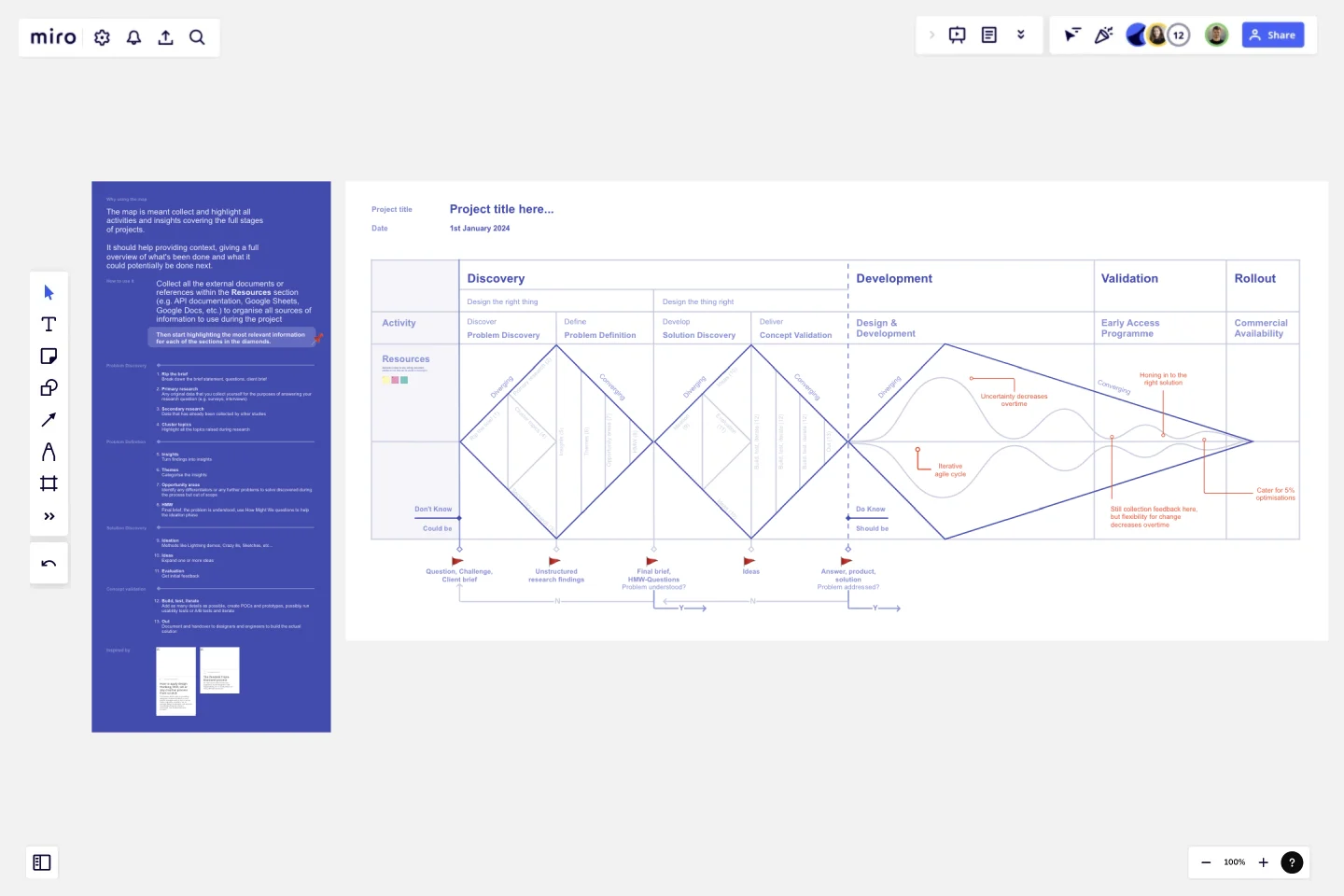[Triple Diamond] Project Map
In summary, the project map serves as a comprehensive tool for collecting, organising, and presenting information across all stages of project execution.
By providing context, highlighting past achievements, and delineating future actions, it facilitates informed decision-making, fosters collaboration, and promotes adaptive planning. As a dynamic and versatile resource, the map empowers stakeholders to navigate the complexities of project management with clarity and confidence. The purpose of the map is to comprehensively capture and illuminate all activities and insights that span across the entirety of the project stages. Its primary objective is to offer context and provide a holistic overview of past accomplishments while also delineating potential future actions.
The map serves as a repository for all project-related endeavors, encompassing initiation, planning, execution, monitoring, and closure phases. Consolidating information from each stage, it offers stakeholders a clear understanding of the project's progression and current standing.
One of the key functions of the map is to provide context. It achieves this by organizing data in a manner that illustrates the interconnectedness of various project components. Through visual representation, stakeholders can discern the relationships between different tasks, milestones, and outcomes. This contextualization facilitates informed decision-making and ensures alignment with overarching project objectives.
Moreover, the map offers a comprehensive overview of completed activities. By cataloging past accomplishments, it enables stakeholders to appreciate the journey thus far and recognise milestones achieved. This retrospective analysis not only instills a sense of progress but also provides valuable insights into the efficacy of previous approaches. Understanding what has already been accomplished serves as a foundation for devising future strategies and optimizing resource allocation.
In addition to showcasing past achievements, the map serves as a springboard for future endeavors. By delineating potential next steps, it empowers stakeholders to chart the course forward with clarity and purpose. Whether identifying areas for improvement, anticipating challenges, or exploring new opportunities, the map serves as a roadmap for informed decision-making. It not only guides strategic planning but also fosters innovation and proactive problem-solving.
Furthermore, the map facilitates effective communication and collaboration among project stakeholders. By offering a centralized platform for sharing information and insights, it promotes transparency and alignment of goals. Whether engaging with team members, clients, or external partners, stakeholders can leverage the map to convey progress, discuss strategies, and solicit feedback. This collaborative approach fosters a sense of ownership and collective responsibility, thereby enhancing overall project outcomes.
Another important aspect of the map is its adaptability. Recognising that projects are dynamic and subject to change, the map is designed to accommodate evolving circumstances and requirements. Through regular updates and revisions, it remains current and relevant, reflecting the latest developments and insights. This flexibility ensures that stakeholders are equipped with up-to-date information to make timely and informed decisions. Any feedback is appreciated if you use it for your projects!
This template was created by Stefano D'Avascio.
Get started with this template right now.
The Product Storyboard
Works best for:
Product Management, Planning
The Product Storyboard template enables product managers to visualize product experiences and user journeys. By mapping out key touchpoints, interactions, and scenarios, this template helps teams understand user needs and pain points. With sections for defining user personas, storyboarding user flows, and capturing feedback, it supports iterative product design and validation. This template serves as a storytelling tool for communicating product visions and guiding product development efforts towards delivering exceptional user experiences.
Service Blueprint by Habanero
Works best for:
Service Blueprint
Optimize your service processes with the Service Blueprint Habanero. This template allows you to map out and scrutinize each aspect of your service delivery, highlighting customer touchpoints and internal processes. Use it to identify inefficiencies, streamline operations, and enhance the overall customer experience. Perfect for service designers, managers, and improvement teams, it offers a detailed approach to refining and innovating your service offerings.
Salesforce Implementation Plan
Works best for:
Roadmap, Planning, Mapping
The Salesforce Implementation Plan template offers a structured framework for planning and executing Salesforce deployment projects. By outlining key milestones, tasks, and dependencies, teams can ensure a smooth transition to the Salesforce platform. This template facilitates collaboration between IT and business teams, ensuring that implementation efforts are aligned with strategic objectives and deliver value to stakeholders.
Entity–Relationship Diagram (ERD) HR Management System Template
Works best for:
ERD
The Entity–Relationship Diagram (ERD) HR Management System Template in Miro is designed to streamline the management of employee-related information and processes within an organization. This template allows for the visualization and organization of complex HR systems, making it easier to understand relationships and processes. It enables users to map out departments, positions, and employee details, including attendance records, payroll, and performance reviews.
Recruitment Strategy Roadmap
Works best for:
Roadmap, Planning, Mapping
The Recruitment Strategy Roadmap template helps organizations plan and execute their talent acquisition initiatives effectively. It provides a structured framework for identifying hiring needs, sourcing candidates, and evaluating recruitment channels. By aligning recruitment efforts with business objectives, organizations can attract and retain top talent, driving organizational growth and success.
Budget Planning Template
Works best for:
Planning
A budget template is a comprehensive yet flexible framework that allows you to monitor and control your finances. With user-friendly functions and numerous customization options, this tool helps you create a budget tailored to your specific needs and goals. Whether new to budgeting or an experienced financial planner, a budget template is an excellent tool to help you manage finances effectively.
